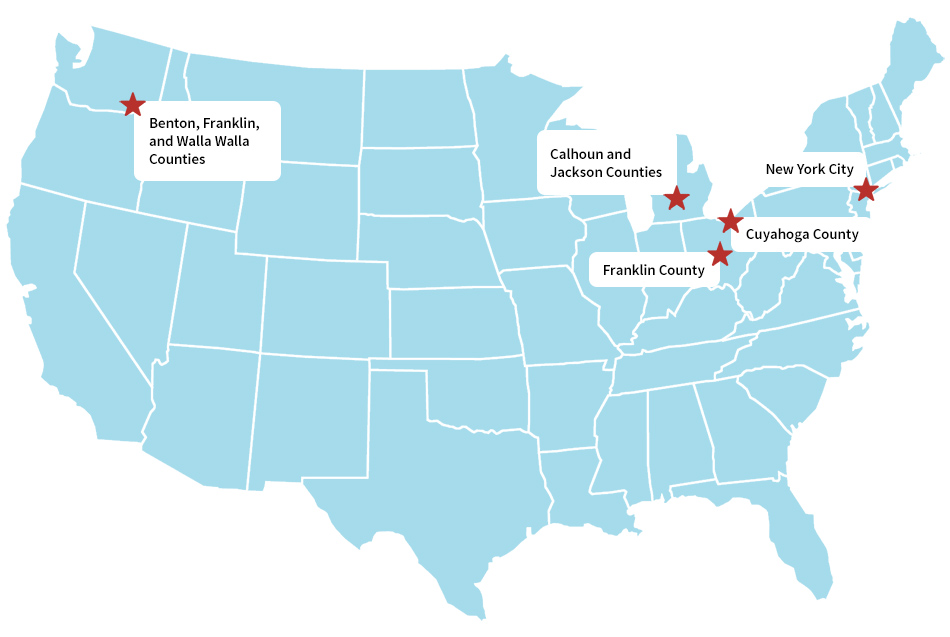How Child Support Agencies Can Help Parents Train for Better Jobs

Parents who are unemployed or underemployed have a limited ability to pay child support because of low earnings. There is growing recognition that child support programs need to address parents’ financial capacity to pay their support obligations, and many child support agencies across the country now provide services aimed at improving the quality of parents’ employment and increasing their earnings.
Most child support-led employment initiatives focus on case management, job readiness activities, job search assistance, and job placement. The Families Forward Demonstration (FFD) sought to test a more intensive approach—led by child support programs—to help parents increase their earning potential by training them in occupational skills needed by local employers. Building on positive findings from sector-focused employment programs, FFD worked with child support agencies to offer:
|
Skills training for well-paying jobs in specific industries and occupations where there is strong local demand and opportunities for advancement |
Employment and wraparound services that are tailored to help parents get and keep jobs in their chosen industry |
Responsive child support services to make it easier for parents to take part in training and to navigate their support obligations in a less punitive manner |

Between 2018 and 2020, FFD programs ran in a mix of large and mid-sized cities, suburbs, and rural areas with varied economic and labor market conditions. An outcome evaluation found promising results on training completion and child support compliance by participating parents.
Child support agencies in FFD analyzed local child support records and conducted focus groups with parents to understand the characteristics and interests of the parents who were most likely to benefit from the programs. Then, they collected input from local workforce and economic development organizations, employer groups (like chambers of commerce and trade associations), community colleges, and training providers to identify occupations that were sought by local employers and seemed to offer parents the best chances for success. The FFD team at MDRC used insights from the WorkAdvance sectoral project to develop the following questions to help child support practitioners assess the potential of various occupations and narrow the list of training opportunities that they would offer to parents.
The steps and questions below may help state and local child support agencies identify occupational training opportunities. This is not a checklist for selecting occupations or providers, but rather a tool to guide the process of building the knowledge that child support agencies need to make informed decisions about developing training programs for parents.
In FFD, each child support agency assembled a varied portfolio of occupational training tracks that attempted to balance the aspirational criteria outlined below with the scope of actual local opportunities and capacity. For example, some occupations offered excellent starting wages but required tenth-grade math skills to begin training. Other occupational tracks offered lower starting wages but realistic advancement paths. Among training providers, some worked closely with local employers to shape training content and place graduates, while other providers simply relied on their track record of graduates finding and keeping the jobs for which they trained.
1. Assess local employers’ demand for workers.
The first step in this process is identifying local industries where demand is strong for entry-level or middle-skill employees, with wages for these jobs that are higher than what parents could secure on their own without further skills training. It’s also important to consider the personal barriers (education and skill level) and systemic barriers (such as employer practices) that parents may face in obtaining a job in their field of interest. For example, many jobs disqualify people who have had prior criminal justice involvement. Key questions to consider:
- Which industries have current and expected future job growth, and have accessible advancement opportunities? Where are the good entry-level wages—ideally, at or above the median pay level among all jobs requiring a high school diploma plus some occupational training?
- Who are the important employers in the high-growth sectors, and what are their pipelines for recruiting candidates? What is the current level of demand (that is, jobs available) for specific occupations?
- What skills, competencies, certifications, and experiences are needed to break into a particular field? What occupations are open to applicants with only a high school diploma or to program participants with prior justice system involvement?
2. Assess how training options align with the needs and interests of potential trainees.
Next, agencies should examine the training requirements for the occupations and sectors identified in the first step. FFD sought occupational training options that met the needs of local employers but had relatively low educational and skill barriers to entry and did not take more than six months to complete. For parents with low incomes who are struggling to make ends meet and to pay child support, child support programs should prioritize occupations that can provide a rapid earnings boost with shorter-term training, while connecting them to a career pathway with future advancement options. Key questions to consider:
- What skills and competencies are required to start a training track (such as literacy and numeracy levels or physical requirements)? What types of assessments are conducted for training participant selection?
- What is the duration and intensity of training?
- Does the training offer an industry-recognized credential or certification? If so, is it part of a stackable sequence of training and credentials that could help workers move up a career ladder over time and into higher-paying jobs?
- What kinds of jobs and advancement opportunities can the training lead to? For example, are the skills portable across different employers or industries?
3. Assess the capacity and employer connections of local training providers.
Based on evidence from sectoral employment programs, child support agencies should prioritize programs with strong employer connections and incorporate sector-appropriate career readiness services and wraparound support services with technical skills training. The programs should be easily accessible to participants within their communities. It is also important to review performance data for training programs and prioritize providers with systems for using data for program monitoring and improvement. Key questions to consider:
- Does the training provider employ dedicated job developers? Does it have partnerships with industry associations or other intermediaries to inform its training content and place training participants into jobs?
- Does the provider use a curriculum endorsed or informed by employers? Does it offer hands-on, experiential learning or on-the-job training?
- Does the provider offer the following services either in-house or through partners:
- Instruction in basic literacy or numeracy skills to help participants access trainings of their interest?
- Work readiness training or career coaching?
- Individualized support through case management?
- Wraparound services to address barriers to employment, such as transportation?
- Does the provider work with participants and employers on retention and advancement after participants are placed in their first jobs?
- Does the provider track enrollment and performance data, including the number of individuals and cohorts served annually, and training completion rates?
- What are the provider’s placement and retention rates for targeted jobs? What types of employers predominated among those placements?
- Does the provider offer training at multiple locations within the jurisdiction? Does it offer part-time or evening classes?
4. Develop a plan to procure services.
Child support agencies should assess their own procurement rules to develop a plan for acquiring services from training providers. In some FFD jurisdictions, agencies found it less challenging to purchase services from providers who have experience contracting with local governments, which can be a consideration when selecting providers. Key questions to consider:
- Would the child support agency contract with vendors directly or through an intermediary (such as the workforce development board)?
- Would a competitive bid process be required for vendor selection?
- What are the steps and approvals required for service procurement and what were the timing implications?
- To what extent could child support agencies use performance-based contracting with vendors to create incentives for achieving specific, measurable training and employment outcomes?
Interested in learning more about how child support agencies can respond more effectively to parents who owe child support? See MDRC’s research about innovative and promising practices.





